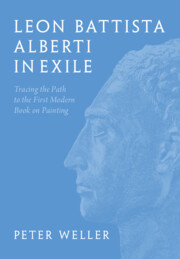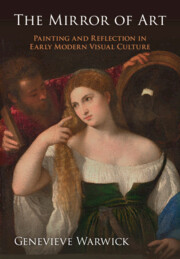Refine search
Actions for selected content:
76 results
Tracing the 14C bomb peak in Pierre Soulages’ artworks to improve radiocarbon dating of 20th century paintings
-
- Journal:
- Radiocarbon , First View
- Published online by Cambridge University Press:
- 06 November 2025, pp. 1-11
-
- Article
-
- You have access
- Open access
- HTML
- Export citation
6 - Haydn in Plain Sight: A Reception History of Matisse’s The Music Lesson
-
-
- Book:
- Haydn Studies 2
- Published online:
- 18 October 2025
- Print publication:
- 16 October 2025, pp 127-154
-
- Chapter
- Export citation
13 - Liturgy, Icons, and Images
- from Part III - Liturgy and the Arts
-
-
- Book:
- The Cambridge Companion to Christian Liturgy
- Published online:
- 19 September 2025
- Print publication:
- 09 October 2025, pp 232-248
-
- Chapter
- Export citation
7 - Remedial Relief
-
-
- Book:
- Relief in Greek, Roman, and Late Antique Art
- Published online:
- 11 October 2025
- Print publication:
- 25 September 2025, pp 232-258
-
- Chapter
- Export citation
Chapter 10 - Ekphrasis in Sight and Song
- from Part II - Forms and Genres
-
-
- Book:
- Michael Field in Context
- Published online:
- 03 October 2025
- Print publication:
- 25 September 2025, pp 86-93
-
- Chapter
- Export citation
Chapter 7 - Young children’s semiosis with artworks in residence
-
-
- Book:
- The Arts and Meaning-Making with Children
- Published online:
- 11 September 2025
- Print publication:
- 25 September 2025, pp 141-162
-
- Chapter
- Export citation
Chapter 8 - Learning in visual arts
- from Part 2 - What: the arts learning areas
-
- Book:
- Teaching the Arts
- Published online:
- 28 July 2025
- Print publication:
- 06 August 2025, pp 235-278
-
- Chapter
- Export citation
Chapter 22 - Boulez and Visual Arts
- from Part IV - Creative Engagements beyond Music
-
-
- Book:
- Boulez in Context
- Published online:
- 08 July 2025
- Print publication:
- 24 July 2025, pp 235-243
-
- Chapter
- Export citation
Chapter 17 - Lady Gregory
- from Part III - Collaborators and Critics
-
-
- Book:
- Sean O'Casey in Context
- Published online:
- 23 June 2025
- Print publication:
- 10 July 2025, pp 182-191
-
- Chapter
- Export citation
22 - The Holocaust and the Visual Arts: Perplexity, Meanings
- from Part IV - Culture and Fields
-
-
- Book:
- The Cambridge History of the Holocaust
- Published online:
- 16 May 2025
- Print publication:
- 12 June 2025, pp 510-538
-
- Chapter
- Export citation
2 - Rome in 900
-
- Book:
- Rome in the Tenth Century
- Published online:
- 01 April 2025
- Print publication:
- 24 April 2025, pp 12-32
-
- Chapter
- Export citation
Chapter 11 - The Visual and Plastic Arts
- from Part II - Intellectual, Cultural, and Political Contexts
-
-
- Book:
- Percy Shelley in Context
- Published online:
- 17 April 2025
- Print publication:
- 24 April 2025, pp 82-90
-
- Chapter
- Export citation

Leon Battista Alberti in Exile
- Tracing the Path to the First Modern Book on Painting
-
- Published online:
- 07 February 2025
- Print publication:
- 06 March 2025
Crystalline, Organic, Energetic: Analogy, Modulation, and Art History in Deleuze’s Lectures on Painting (1981)
-
- Journal:
- Dialogue: Canadian Philosophical Review / Revue canadienne de philosophie , First View
- Published online by Cambridge University Press:
- 27 January 2025, pp. 1-25
-
- Article
-
- You have access
- Open access
- HTML
- Export citation
Chapter 11 - Collingwood on “Painting Imaginatively” and the Expressive Nature of the Artwork
- from Part II - Issues in Collingwood’s Philosophy
-
-
- Book:
- Interpreting R. G. Collingwood
- Published online:
- 22 November 2024
- Print publication:
- 05 December 2024, pp 204-222
-
- Chapter
- Export citation

The Mirror of Art
- Painting and Reflection in Early Modern Visual Culture
-
- Published online:
- 28 November 2024
- Print publication:
- 28 November 2024
Introduction
-
- Book:
- The Mirror of Art
- Published online:
- 28 November 2024
- Print publication:
- 28 November 2024, pp 1-16
-
- Chapter
- Export citation
Chapter 2 - Contrasting Pairs and Twin Graves
- from Part I - Between Literature and Scholarship
-
-
- Book:
- Writing Literary History in the Greek and Roman World
- Published online:
- 07 June 2024
- Print publication:
- 27 June 2024, pp 40-61
-
- Chapter
- Export citation
Five - Singular, Seriated, Similar
-
- Book:
- Minoan Zoomorphic Culture
- Published online:
- 17 May 2024
- Print publication:
- 06 June 2024, pp 246-309
-
- Chapter
- Export citation
15 - Artistic Witness and Response to Environmental Violence
- from Part III - Environmental Violence Impacts, Responses, Resistance, and Alternatives
-
-
- Book:
- Exploring Environmental Violence
- Published online:
- 06 June 2024
- Print publication:
- 09 May 2024, pp 318-339
-
- Chapter
-
- You have access
- Open access
- HTML
- Export citation
